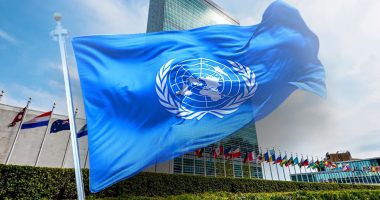Share this @internewscast.com
JPMorgan Chase has warned that the United States is now barreling toward a recession, and that even an immediate rollback of President Trump’s sweeping new tariffs may not be enough to prevent it.
JPMorgan’s chief economist, Bruce Kasman, issued the grave assessment on Thursday, raising the firm’s recession forecast to 60%, up from 40% just days earlier.
The revised figure came following the White House’s announcement of a 10% across-the-board tariff on all imported goods, along with even steeper penalties for nations with sizable trade surpluses.
The move jolted markets, disrupted business planning, and has rattled economists who now believe a looming downturn is all but inevitable.
‘Is there an opportunity to put Humpty Dumpty back on the wall here?’ Kasman asked during The Weekender, JPMorgan’s weekly economics podcast.
‘I think it’s hard for me to see the scenario where you roll this back in a way that we’re sitting here in two weeks and we feel like we want to take our recession call back.’
The remark underscored a fundamental shift in sentiment within JPMorgan’s economic team.
In an internal research note titled ‘There will be blood,’ Kasman and his team compared the tariff package to a tax hike of historic proportions – the largest since Lyndon B. Johnson’s tax surcharge in 1968.

JPMorgan Chase has warned that the United States is now barreling toward a recession, and that even an immediate rollback of Trump’s sweeping new tariffs may not be enough to stop it

President Trump’s tariff regime represents a wholesale rewrite of US trade policy, rooted in what the administration describes as ‘reciprocal fairness’

JPMorgan’s chief economist, Bruce Kasman, issued the grave assessment on Thursday, raising the firm’s recession forecast to 60%, up from 40% just days earlier
‘The effect of this tax hike is likely to be magnified – through retaliation, a slide in U.S. business sentiment, and supply chain disruptions,’ the economists wrote.
‘We thus emphasize that these policies, if sustained, would likely push the U.S. and possibly global economy into recession this year.’
They further warned that while immediate implementation could invite short-term negotiations, the structural hit to business confidence and global trade patterns would be difficult to undo.
The S&P 500 plunged nearly 6% on Thursday and a further 4% on Friday – its sharpest drop since June 2020, as markets appeared to be absorbing the reality that the U.S. economy may be entering a destabilizing period of uncertainty.
The drop closed the worst week for the S&P 500 since March 2020, when the pandemic ripped through the global economy.
The Dow Jones Industrial Average plunged 2,231 points, or 5.5% while the Nasdaq composite tumbled 5.8% to pull more than 20% below its record set in December.
President Trump’s tariff regime represents a wholesale rewrite of US trade policy, rooted in what the administration describes as ‘reciprocal fairness.’

A blanket 10% tariff now applies to all US imports. In addition, specific countries face steep surcharges, including China (34%), Japan (24%), the EU (20%), and Vietnam (46%)

Traders seen on the floor of the New York Stock Exchange as stocks fell sharply on Friday
A blanket 10% tariff now applies to all US imports. In addition, specific countries face steep surcharges, including China (34%), Japan (24%), the European Union (20%), and Vietnam (46%).
The levies are calculated based on each country’s trade imbalance with the US, a formula administration officials claim reflects fairness but which economists argue is entirely arbitrary and economically perilous.
‘These tariffs will protect American workers, rebuild our factories, and put America First,’ Trump declared Wednesday in a televised address framing the move as a patriotic duty.
On Friday he added on social media that he had spoken with Vietnamese President To Lam about reducing his country’s 46% tariff rate.
But economists across the political spectrum have sounded alarms, pointing to a cascade of knock-on effects: higher prices for US consumers, shrinking demand from abroad, and reconfigured, or broken, global supply chains.
Kasman was blunt: ‘The idea that this is a business-friendly administration – that’s broken.’
JPMorgan’s economists estimated the effective increase in tariffs this year – 22 percentage points – represents the single biggest tax shock since the Johnson administration.

JPMorgan’s chief economist raised the firm’s recession forecast to 60%, up from 40% just days earlier. Pictured, Jamie Dimon, Chairman and CEO of JPMorgan Chase

Traders are seen on the floor of the NYSE as President Donald Trump’s sweeping new tariffs taken effect on major US trading partners
Using models from the International Monetary Fund, they warned that a sustained trade war could shave 2 percentage points off US GDP and 1 point off global output.
That projection comes amid growing evidence that American households and businesses are already adjusting to higher prices and tighter margins.
Automakers say vehicle prices may rise 11–12%. Retailers are also bracing for surging costs on everything from cereal to clothing.
Kasman also argued that there is also a psychological side to the tariffs making business and stable trade policies far more unpredictable.
‘There’s a clarity to what’s happening now,’ Kasman said. ‘The sense that the rules are stable, that we have predictability – that’s gone.’
Joseph Lupton, another economist at JPMorgan, echoed the sentiment. ‘Even if the numbers come down a bit, we’re still imposing significant trade penalties,’ he said.
Companies, unsure of what comes next, are already scaling back investment plans with capital expenditures are being delayed or canceled.
The Federal Reserve, which had recently paused rate hikes, may be compelled to cut rates – not to stimulate growth, but to cushion the fall.
JPMorgan made clear that it is not yet formally adjusting its GDP forecast – a nod to the possibility that the situation could evolve, but their economists believe the economic outlook is gloomier than at any time since the start of the pandemic.

















